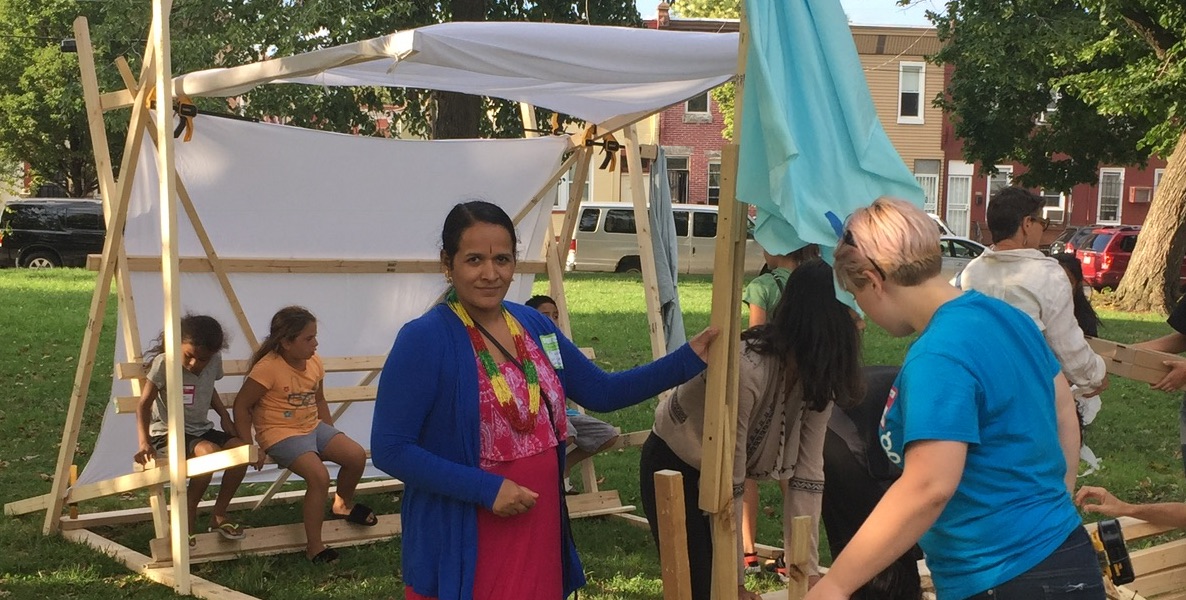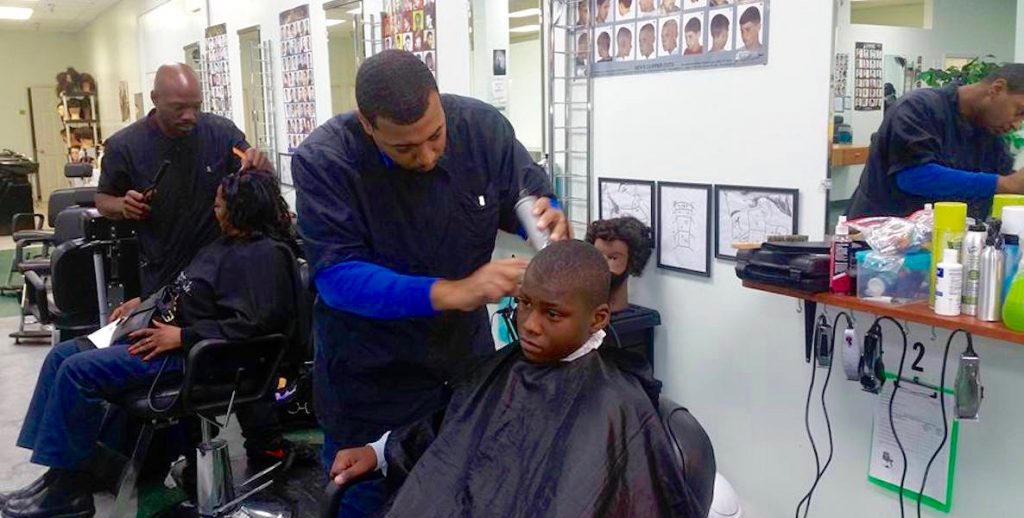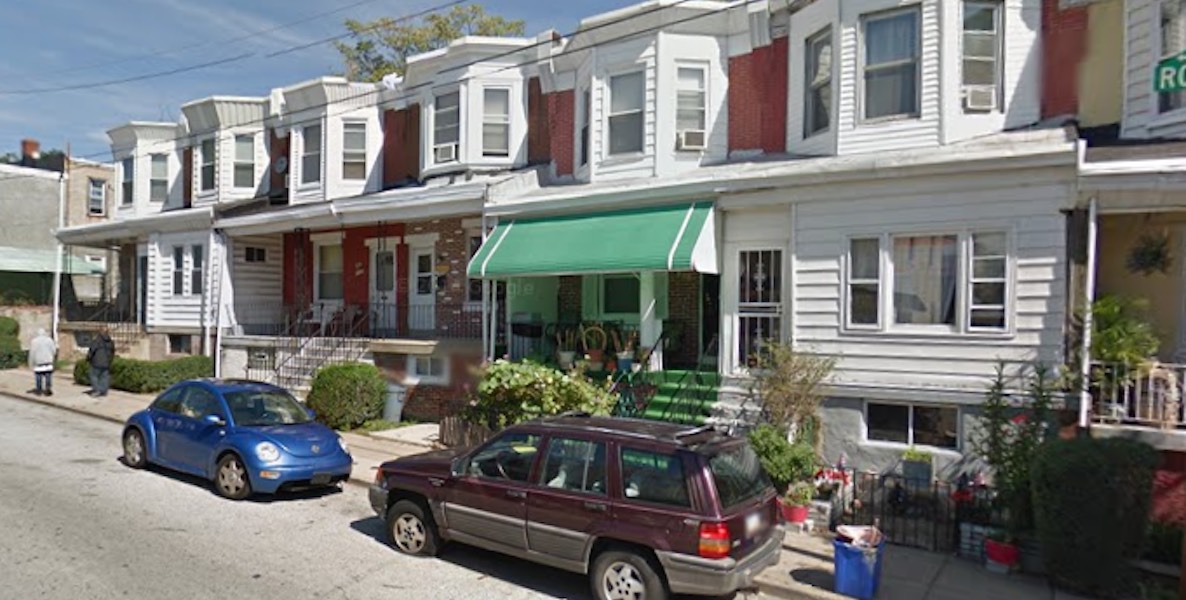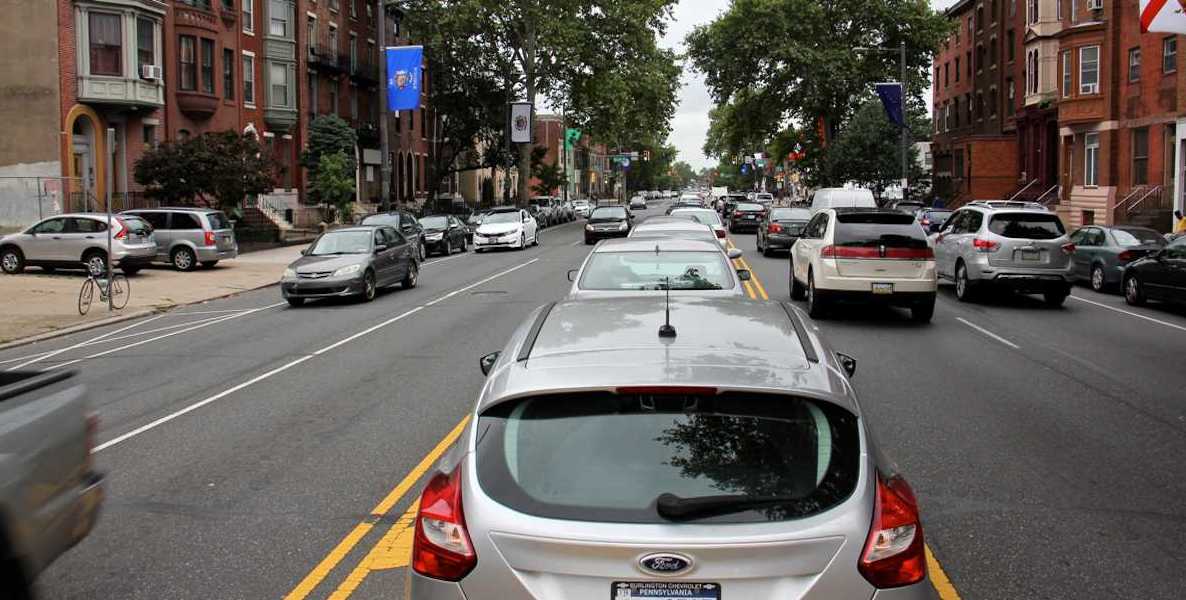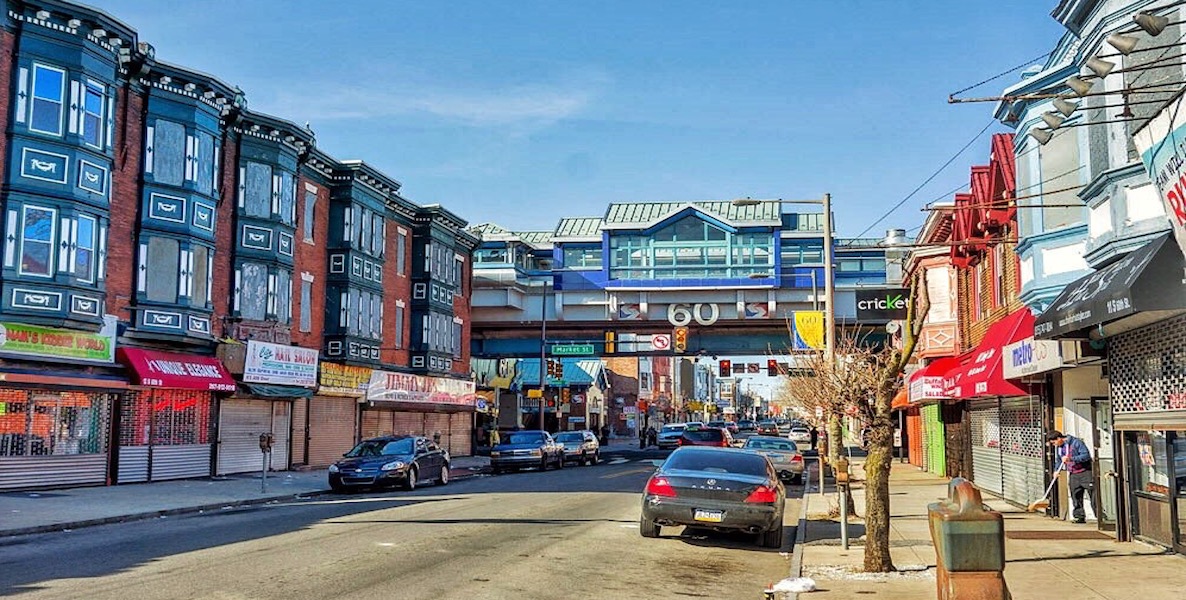Kizzy Raw counts her business as a success story. Her store, So Raw Apparel, was the first retail client in a swath of buildings rehabbed as part of a revitalization project on 60th Street in West Philadelphia. The small space is filled with hoodies, T-shirts, bags and sewing equipment.
Before she moved into her new shop three years ago, the young, outgoing entrepreneur made t-shirts in her basement in a house a few blocks to the south. Now she sells clothes just a block from an El stop and has built her brand to the point where loyal customers shout out when they see a stranger wearing her shirts on the street.
Be Part of the Solution
Become a Citizen member.Outside, the sidewalks host a steady stream of shoppers and passersby, dozens out at midday on a summer Saturday. “I’m in the perfect spot,” Raw says. “What better place than my own neighborhood?”
![]() The 60th Street commercial corridor, set in the Cobbs Creek area, is not as large or high-profile as shopping districts like 52nd or 69th Street, but serves as a test case for smaller, less-prominent avenues nevertheless crucial to the neighborhoods they support. Cobbs Creek is 96 percent black with median annual household income hovering in the $20,000 to $30,000 range, according to U.S. Census data. Residents reminisce about a once-thriving corridor that hosted a wealth of options like a theater, hat shops, a skating rink and a butcher.
The 60th Street commercial corridor, set in the Cobbs Creek area, is not as large or high-profile as shopping districts like 52nd or 69th Street, but serves as a test case for smaller, less-prominent avenues nevertheless crucial to the neighborhoods they support. Cobbs Creek is 96 percent black with median annual household income hovering in the $20,000 to $30,000 range, according to U.S. Census data. Residents reminisce about a once-thriving corridor that hosted a wealth of options like a theater, hat shops, a skating rink and a butcher.
But decades of decline—the same disinvestment and downturns that plundered neighborhoods across the city in the latter portion of the 20th century—were capped by a decade of construction on the El in West Philadelphia, disrupting the flow of the street and leaving it pocked with vacancies. The massive project, which included rebuilding the station at 60th and Market, endured years of delays and a change in contractor midstream, prolonging the misery of residents and shopkeepers until its completion in 2009.
The corridor has taken large steps forward in just a few years thanks to a coordinated revitalization effort and the arrival of a number of new businesses. Before and after photos speak for themselves—boarded windows, peeling paint and crumbling facades have been replaced with rebuilt storefronts and vibrant paint jobs. The ultimate story of 60th Street is incomplete; its viability so far is a tenuous success dangling between hope and energy on one side, drugs and crime on the other in this economically vulnerable neighborhood.

The recent development was spearheaded by the combined efforts of the non-profit Partnership Community Development Corporation and West Philadelphia Real Estate (WPRE), a for-profit realtor. Capital for the project came via the Reinvestment Fund from the federal Community Development Financial Institutions Bond Guarantee Program, specifically geared toward underserved communities. Following the completion of the initial phase of the project in 2015, Partnership CDC stepped back and WPRE has taken the lead moving forward.
“The corridor is a place with a strong history as an active and vibrant commercial corridor,” says Andy Rachlin, managing director for lending and investments for The Reinvestment Fund. “There’s a really strong underlying neighborhood there with a dense and stable population in need of housing and positive local retail, places they can go to buy the everyday goods of life.”
The project followed a strategy of infill development, or building among existing structures, a more effective way to revitalize a neighborhood than knocking down an area and starting from scratch, Rachlin says. This has proved successful in other revitalized commercial corridors, in Mt. Airy, Germantown, Passyunk and Lancaster Avenues.
Cobbs Creek is 96 percent black with median annual household income hovering in the $20,000 to $30,000 range. Residents reminisce about a once-thriving corridor that hosted a theater, hat shops, a skating rink and a butcher. But decades of decline were capped by a decade of construction on the El in West Philadelphia, disrupting the flow of the street and leaving properties pocked with vacancy.
Scattered site developments can be more challenging to manage than one large building, but infill serves to preserve the character and existing institutions in a neighborhood. WPRE fit the bill as an appropriate partner because they have historically developed scattered-site low income housing. The 60th Street project is the first in which they purchased and developed a concentrated stock of properties with an eye toward improving an entire corridor.

The partnership purchased 45 properties on 60th Street which they rehabbed or rebuilt, resulting in 21 new commercial storefronts and 60 units of affordable housing, all LEED-certified in compliance with green building criteria. “These were all vacant a few years ago,” says George Bantel, a founding partner of WPRE, indicating a row of storefronts between Chestnut and Sansom. Now the buildings host child care centers, hair dressers, apparel shops and other offerings. Finding the right mix of retailers has been a challenge, Bantel says. The group intended to rent to a more diverse selection, but the salons have been successful despite heavy competition, while other stores, like men’s suit shops, have failed.
The commercial portion of the street previously ran seven blocks south to Catherine Street, and scattered storefronts still operate on the southernmost blocks, but the revitalization project focused on consolidating retail between Spruce and Market, turning properties below Spruce into fully residential units.
The partnership purchased 45 properties on the corridor which they rehabbed or rebuilt, resulting in 21 new commercial storefronts and 60 units of affordable housing, all LEED-certified in compliance with green building criteria. Overall vacancy on the strip has decreased from 43 to 23 percent.
WPRE now intends to develop a multi-lot property around the old Imperial Theatre building, a large, empty structure at Chancellor Street, and plopping a park next door with space to show outdoor movies. “We want something with appeal to a mass market, like a gym, or a Chuck E. Cheese’s, that would have people constantly coming and going,” Bantel says.
![]() Beyond the theater, he hopes the company’s work will start a domino effect. “The street needs more investment, but not from us,” he says. “We don’t want to own the whole corridor.”
Beyond the theater, he hopes the company’s work will start a domino effect. “The street needs more investment, but not from us,” he says. “We don’t want to own the whole corridor.”
Initial results have shown promise. After construction was completed and the new shops rented out in 2015, an additional 10 stores unrelated to the project opened on the corridor, including a small supermarket. Overall vacancy on the strip decreased from 43 to 23 percent, according to a WPRE census. From Market Street to Locust, nearly every storefront is occupied, though south of Locust numerous empty lots and shuttered buildings remain.
“The businesses give people hope, an identity, something to say, look at our community, it’s getting better,” says Tarik Ferron of the Masjid Mujahideen mosque at 60th and Osage, who worked with the partnership to solicit community input during the project. “I can go down here and buy a T-shirt, I can go here and buy a water ice.” To maintain the momentum, Ferron would like to see resources to help train business owners to decrease turnover and maintain stability on the corridor.
On the street, there is cautious optimism. Patricia Smith, who has lived in the neighborhood for 52 years, says she is encouraged by the new wave of store openings but wants to see more focus on African American-owned businesses to keep money within the community. “Growing up, we had our own fish market, cleaners, clothing stores,” Smith says. “When they remodeled the El, some black stores didn’t return.”
![]() Crime is an ongoing problem. According to police statistics, there have been 21 aggravated assaults and 13 robberies over the last six months on 60th between Market and Catherine Streets, and the street had a moment of national infamy in 2016 when a man who later pledged allegiance to the Islamic State ambushed and shot a police officer. Bantel says five of his retail tenants moved out after their initial two-year lease, most citing crime as the main reason they left. Shop owners complained about young men loitering outside stores, and harassing women walking by.
Crime is an ongoing problem. According to police statistics, there have been 21 aggravated assaults and 13 robberies over the last six months on 60th between Market and Catherine Streets, and the street had a moment of national infamy in 2016 when a man who later pledged allegiance to the Islamic State ambushed and shot a police officer. Bantel says five of his retail tenants moved out after their initial two-year lease, most citing crime as the main reason they left. Shop owners complained about young men loitering outside stores, and harassing women walking by.
Coordination between businesses also remains a challenge. Several shopkeepers mention that they don’t view the local business group as particularly visible or active. Meanwhile, Abdul Salaam, president of the 60th Street/West Market Street Business Association, says the group tries holding events but doesn’t garner much participation. “We’re working on trying to get people out,” he says, “but people in business call me, say I’ll be there, then they don’t show.”
For Jabari Jones, president of the West Philadelphia Corridor Collaborative, 60th Street is an example of the impact outside investment can make. To get the most from the corridor, he says, investors, the community and business associations all need to work together, with more beautification projects, better lighting, public safety and more advertising. “You really have to inspire engagement,” Jones says. “Any of those organizations of associations are only going to be as strong, stable and powerful as they have committed members.”
The next few years will reveal if the corridor can transform from a qualified success to a thriving shopping destination. “We would love it to be a destination,” Bantel says. “Eventually it will get its own identity.”
Header Photo: West Philadelphia Real Estate


